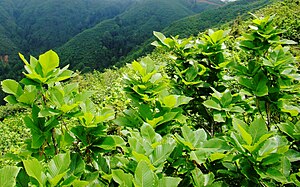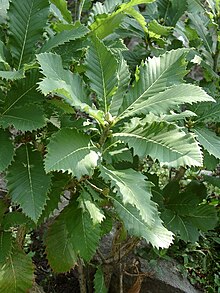Armenian oak
| Armenian oak | ||||||||||||
|---|---|---|---|---|---|---|---|---|---|---|---|---|

Armenian oak ( Quercus pontica ) |
||||||||||||
| Systematics | ||||||||||||
|
||||||||||||
| Scientific name | ||||||||||||
| Quercus pontica | ||||||||||||
| K. Koch |
The Armenian oak ( Quercus pontica ), also Pontus oak called, is a plant from the genus of oak ( Quercus ). It is native to northern Asia Minor , Armenia and the Caucasus . The proximity to the Black Sea ("pontica") explains its specific epithet pontica and the common name Pontic oak.
description
The Armenian oak grows as a broad, round, large shrub or a stocky, thick, small tree and reaches heights of 4 to 6 meters, and becomes about just as wide with age. The trunk diameter can be up to 40 centimeters. It grows very slowly at 10 centimeters per year. The very stiff, upright branches are bare, noticeably thick and often angular. The main root extends deep into the ground. The bark is gray and irregularly torn lengthways, and forms loose bark plates on old trunks.
The alternate arranged on the branches leaves are stalked yellow and remember the leaves of the chestnut . The simple, relatively large, dark green, leathery and somewhat coarse leaf blade is not lobed with a length of up to 25 centimeters and a width of about 10 centimeters. The leaf margin is serrated irregularly. The underside is colored blue-green and shows clearly raised yellow leaf veins . The autumn color at the end of October is bright gold-yellow, yellow-orange, also brown-yellow. As is typical of other oaks, the leaves remain on the branches for a long time.
The flowering period extends from May to June. The Armenian oak has pendulous, long, yellow-green, catkin-shaped inflorescences . With a length of 2 to 3.5 centimeters, the elongated, egg-shaped, red-brown acorns are sometimes surrounded by half of the fruit cup (cupula), which is covered with closely-fitting, felty scales.
Location and use
The Armenian oak grows as a large, multi-stemmed shrub or small tree on the damp mountain slopes of its south-eastern European homeland; As an ornamental wood, it is used as a single-stemmed tree.
The delicate Armenian oak has been found in parks or gardens, there as a solitary plant or on the edges of trees and in perennial plants since 1885 . It prefers sheltered and sunny locations and should be protected from late frost when young. It is urban climate-proof, heat-resistant and wind-tolerant. The soil should be dry and fresh, permeable and rich in alkaline nutrients. The Armenian oak is one of the most beautiful low oaks because of the splendid autumn colors of the large decorative leaves.
literature
- Alan Mitchell: The forest and park trees of Europe , Paul Parey publishing house, Hamburg and Berlin 1975, ISBN 3-490-05918-2 , page 248
- Allen J. Coombes: Határozó Kézikönyvek, Fák, Egyetemi Nyomda, 1996. ISBN 963 545 038 9
- Linnaea. 22: 319. 1849

